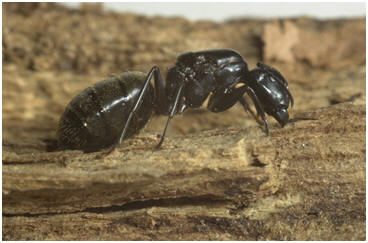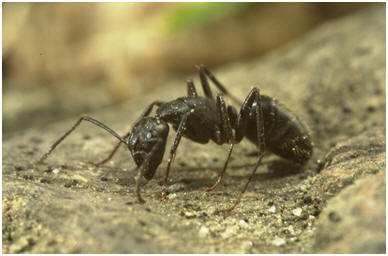
Reproduction
The
life cycle of the Camponotus pennsylvanicus is one that is
both unique to the genus as well as the species. The first matting occurs during the first humid afternoon in
the spring in a process called swarming in which the males dies
shortly after their reproduction process (Sudd
and Franks 1987). Once a new queen (below) has been fertilized through sexual
reproduction, she leaves the parental nest in search of a new
environment to start a new colony (Sudd and
Franks 1987). She
stores
nutrients, in the form of fats, in her alary muscles so that she
will be completely devoted to her first offspring and the beginning
of the building portion of the new colony (Gordon
2010).She finds
the start of a new colony by constructing a small closed cell in the
soil or in wood cavities (Gordon 2010).  Once
the first small workers, roughly 3-10, hatch they immediately
search, or forage, for food; which is the first time the queen will
eat since she left the original nest (Sudd
and Franks 1987). She will lay her eggs twice a year (Moffet
2010). Once these
first workers emerge the queen devotes most of her time to laying
eggs to escalate the numbers exponentially within the colony (Sudd
and Franks 1987).
These workers are produced for 2-3 years before the large workers
even seen in the colony (Gordon 2010).
Mainly these workers are devoted to expanding the colony and
searching for food during the first few years, meaning that they
stay sterile as well (Gordon 2010).
Once
the first small workers, roughly 3-10, hatch they immediately
search, or forage, for food; which is the first time the queen will
eat since she left the original nest (Sudd
and Franks 1987). She will lay her eggs twice a year (Moffet
2010). Once these
first workers emerge the queen devotes most of her time to laying
eggs to escalate the numbers exponentially within the colony (Sudd
and Franks 1987).
These workers are produced for 2-3 years before the large workers
even seen in the colony (Gordon 2010).
Mainly these workers are devoted to expanding the colony and
searching for food during the first few years, meaning that they
stay sterile as well (Gordon 2010).
Once the large workers are produced the small workers only job is to expand the colony and the large workers search for food as well as act as a defensive line against enemy predators (Klotz et. al. Hansen Pospischil and Rust 2008). Four years after the first colony was established the first male drones are produced (Klotz et. al. Hansen Pospischil and Rust 2008). They have wings and are only used for reproduction, in which they die shortly after the process (Gordon 2010). Mature colonies therefore produce both males and females and the colony may last for up to 15 years after the first queen established it (Klotz et. al. Hansen Pospischil and Rust 2008). Each colony may have up to 3000 workers and several queens (Gordon 2010). During the swarming process the male drones (below on the right) may mate with more than one of these queens before they die (Gordon 2010).


Interactions or Home